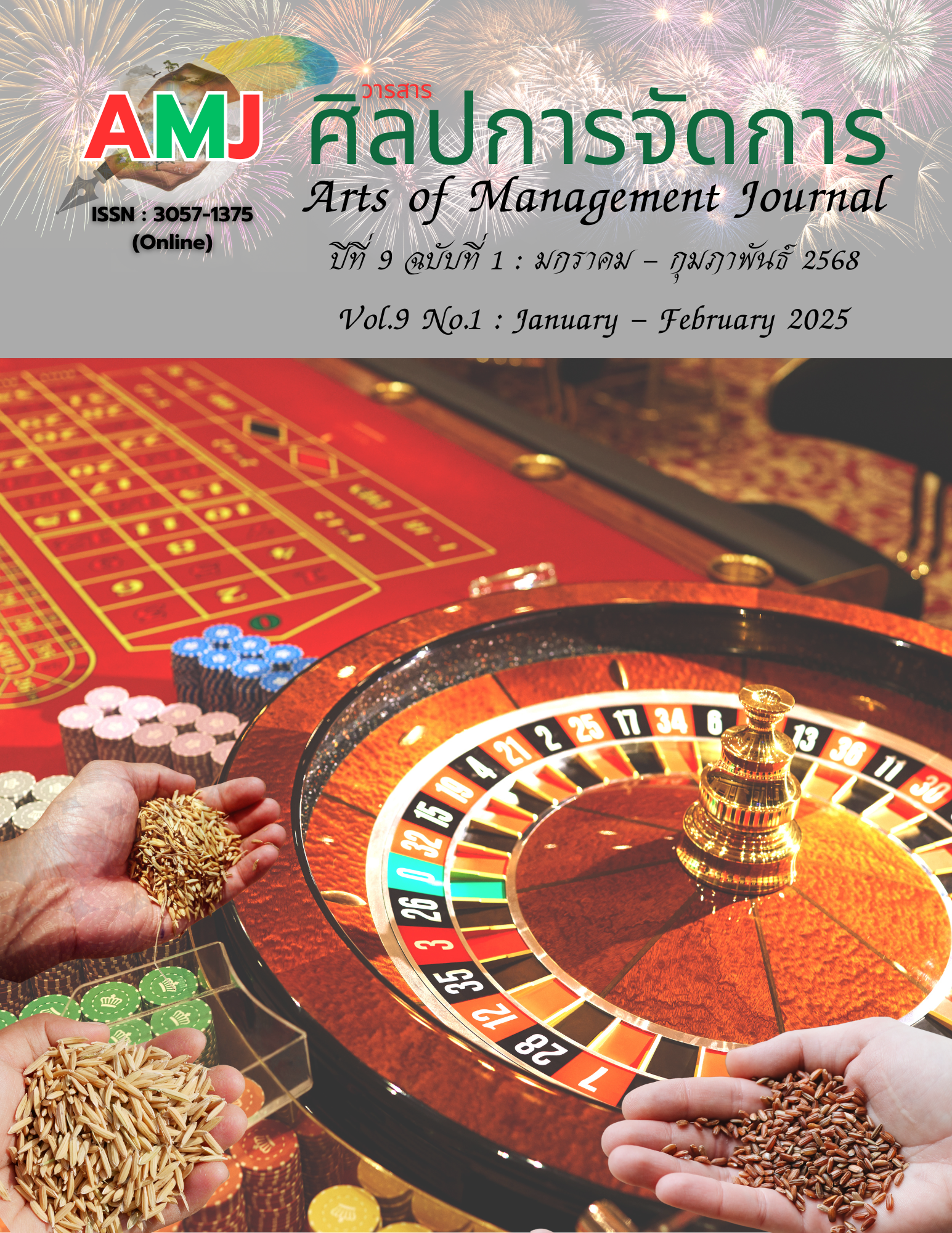กลยุทธ์การสื่อสารเพื่อส่งเสริมการท่องเที่ยวโดยชุมชนอย่างยั่งยืน ของชุมชนปากน้ำประแส อำเภอแกลง จังหวัดระยอง
Main Article Content
บทคัดย่อ
บทความนี้มีวัตถุประสงค์เพื่อ 1) ศึกษาศักยภาพการสื่อสารเพื่อส่งเสริมการท่องเที่ยวโดยชุมชนอย่างยั่งยืนของชุมชนปากน้ำประแส อำเภอแกลง จังหวัดระยอง 2) เพื่อพัฒนากลยุทธ์การสื่อสารเพื่อส่งเสริมการท่องเที่ยวโดยชุมชนอย่างยั่งยืนชุมชนปากน้ำประแส อำเภอแกลง จังหวัดระยอง 3) เพื่อผลิตสื่อประชาสัมพันธ์ส่งเสริมการท่องเที่ยวโดยชุมชนอย่างยั่งยืนของชุมชนปากน้ำประแส อำเภอแกลง จังหวัดระยอง เป็นการวิจัยแบบผสานวิธี เครื่องมือที่ใช้เก็บรวบรวมข้อมูล ได้แก่แบบสัมภาษณ์ ใช้การวิเคราะห์เนื้อหา และแบบสอบถาม ใช้สถิติพื้นฐาน ผลการวิจัยพบว่า 1) นักท่องเที่ยวใช้สื่อสังคมออนไลน์เป็นช่องทางหลักในการรับข้อมูลท่องเที่ยว ต้องการข้อมูลเกี่ยวกับร้านอาหารและผลิตภัณฑ์ท้องถิ่นมากที่สุด การสื่อสารของชุมชนในปัจจุบันยังไม่ครอบคลุมพอ แนะนำให้ใช้สื่อวิดีโอและอินโฟกราฟิก และชุมชนยังขาดการใช้สื่อดิจิทัลและออนไลน์ในการโปรโมทแหล่งท่องเที่ยว ข้อมูลแผนที่ท่องเที่ยวชุมชนไม่มีการอัปเดท ทำให้ข้อมูลไม่เข้าถึงกลุ่มเป้าหมายได้อย่างมีประสิทธิภาพ 2) กลยุทธ์การสื่อสารเพื่อส่งเสริมการท่องเที่ยวโดยชุมชนอย่างยั่งยืนสำหรับชุมชนปากน้ำประแส คือ สื่อวิดีโอสั้น และแผนที่ท่องเที่ยวแบบกราฟิก 3) ผลิตสื่อวิดีโอสั้น 5 คลิป และแผนที่ท่องเที่ยวชุมชนแบบอินโฟกราฟฟิก 1 ไฟล์ เพื่อส่งเสริมการท่องเที่ยวโดยชุมชนอย่างยั่งยืนของชุมชนปากน้ำประแส อำเภอแกลง จังหวัดระยอง
Article Details

This work is licensed under a Creative Commons Attribution-NonCommercial-NoDerivatives 4.0 International License.
ทัศนะและความคิดเห็นที่ปรากฏในบทความในวารสารศิลปการจัดการ ถือเป็นความรับผิดชอบของผู้เขียนบทความนั้น และไม่ถือเป็นทัศนะและความรับผิดชอบของกองบรรณาธิการ ยินยอมว่าบทความเป็นลิขสิทธิ์ของวารสารศิลปการจัดการ
References
Bunleas, P., Limiransuksakul, M., & Suriyawong, K. (2024). Developed short video clips on TikTok employing nano influencers to promote community enterprise tourism at Ban Tham Suea homestay in Kaeng Krachan District, Phetchaburi Province. Journal of Innovation in Educational Management and Research, (6)1, 57-70. https://so02.tci-thaijo.org/ index.php/jemri/article/view/266401
Campos, M. J. Z., Hall, C. M., Lindo, P., & Vanderschaeghe, M. (2011). Can community-based tourism contribute to development and poverty alleviation? Lessons from Nicaragua. Current Issues in Tourism, 14(8), 725–749. DOI:10.1080/13683500.2011.559200
Chung, N., & Koo, C. (2015). The Use of Social Media in Travel Information Search. Telematics and Informatics, 32, 215-229. https://doi.org/10.1016/j.tele.2014.08.005
Choe, J. Y. J., & Kim, S. S. (2018). Effects of tourists’ local food consumption value on attitude, food destination image, and behavioral intention. International Journal of Hospitality Management, 71, 1-10. https://doi.org/10.1016/j.ijhm.2017.11.007
David, F. R. (2015). Strategic management: concepts and cases (15th ed.). Pearson Education.
Devito, J. A. (2018). The interpersonal communication book (15th ed.). Pearson.
Giampiccoli, A., & Saayman, M. (2018). Community-based tourism development model and community participation. African Journal of Hospitality, Tourism and Leisure, 7(4), 1–27.
Goodwin, H., & Santilli, R. (2009). Community-based tourism: A success?. In ICRT Occasional Paper 11. International Centre for Responsible Tourism, Leeds Metropolitan University.
Jones, T. (2023). Communication theories and their applications in modern contexts. Journal of Communication Studies, 45(2), 101-120.
Johnson, P. (2019). Communication strategies in the digital age. Oxford University.
Klaysang, S. (2017). The development of video and online media to promote participatory marketing and tourism in Taling Chan, Bangkok. Humanities and Social Sciences, 12(3), 285-296. https://so06.tci-thaijo.org/index.php/vrurdihsjournal/article/view/107946
Klongdee, K., & Chanamool, N. (2021). Development of Motion Graphic Media Introduction to Ecotourism Nong Bua Community, Chanthaburi. Journal of Applied Information Technology, 7(2), 75-83. https://ph02.tci-thaijo.org/index.php/project-journal/article/view/245034
Leung, D., Law, R., Van Hoof, H., & Buhalis, D. (2013). Social media in tourism and hospitality: A literature review. Journal of Travel & Tourism Marketing, 30(1-2), 3-22. DOI:10.1080/10548408.2013.750919
Pooksawat, A., & Sattararuchi, K. (2013). Public relations under the social media trend. Journal of Public Relations and Advertising, 6(2), 24-38. https://so03.tci-thaijo.org/index.php/jprad/article/view/134052
Suntikul, W., & Dorji, U. (2016). Challenges of community-based tourism in Bhutan. Tourism Management Perspectives, 20, 73–79.
Swarbrooke, J., & Horner, S. (2012). Business travel and tourism (2nd ed.). Routledge.
Smith, J. (2020). Effective business communication. McGraw-Hill.
Pantham, S., & Chaimadan, C. (2020). A study of the management model of cultural tourism communities in the Eastern Special Development Zone: a case study of Pak Nam Prasae community, Rayong province. Suan Dusit University Graduate School, 16(3), 89-106.
Kunakornbodin, S. et al. (2006). Potential and readiness of local restaurants to accommodate tourists in Chiang Rai province. Thailand Research Fund.
Tourism Authority of Thailand. (2020, July). Thailand tourism situation report 2020. https://www.tourismthailand.org/home
Tolkach, D., King, B., & Pearlman, M. (2013). An exploratory study of community-based tourism in Thailand. Tourism Planning & Development, 10(2), 175–190.
Wilcox, D. L., Cameron, G. T., & Reber, B. H. (2013). Public relations: Strategies and tactics (10th ed.). Pearson.
Yoo, K. H., & Gretzel, U. (2011). Influence of personality on travel-related consumer-generated media creation. Computers in Human Behavior, 27, 609–621. https://doi.org/10.1016/j.chb.2010.05.002

